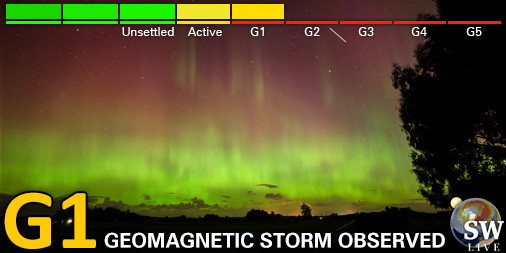Viewing archive of Tuesday, 12 July 2016
Daily bulletin on solar and geomagnetic activity from the SIDC
Issued: 2016 Jul 12 1230 UTC
SIDC Forecast
Solar flares
Quiet conditions (<50% probability of C-class flares)
Geomagnetism
Active conditions expected (A>=20 or K=4)
Solar protons
Quiet
| 10cm flux | Ap | |
|---|---|---|
| 12 Jul 2016 | 095 | 023 |
| 13 Jul 2016 | 094 | 009 |
| 14 Jul 2016 | 095 | 015 |
Bulletin
Over the past 24 hours solar activity has been low. The largest flare was a B9.4 class flare. Active Region (AR) 2564 (Macintosh class:Dao; Mag. type:Beta) produced the largest flare, the B9.4 class flare peaking at 21:33 UT yesterday, the region has shown some evidence of flux emergence in HMI magnetogram observations, but appears stable, this region may increase flaring activity. All other regions appeared stable. No Earth directed Coronal Mass Ejections (CMEs) have been detected. Solar protons have remained at background levels over the past 24 hours. There is currently a large +ve polarity trans-equatorial northern polar coronal hole moving into the Western hemisphere. Solar activity is expected to remain low over the next 24 hours, with a reasonable probability of C-class flares and a low probability of M-class flares. The solar wind speed has increased from around 500 to 600 km/s over the past 24 hours. The total magnetic field strength has fluctuated around 5 nT, but peaked around 9 nT at 08:00 UT this morning. The Bz component fluctuated around 0 nT, but has been largely -ve this morning ranging between -9 and +5 nT. Geomagnetic conditions ranged between Kp index 2-5 (NOAA) and local K index 2-4 (Dourbes) over the past 24 hours. The largely negative Bz experienced this morning combined with the increasing solar wind speed produced Kp 5 conditions, this resulted from a small high speed stream (HSS). The Kp is expected to drop over the next few hours as we move out of the HSS. However, the large northern polar coronal hole moving into the Western hemisphere may increase solar wind speeds again, if coupled with negative Bz we may experience further enhanced geomagnetic activity over the next few days.
Today's estimated international sunspot number (ISN): 061, based on 21 stations.Solar indices for 11 Jul 2016
| Wolf number Catania | 079 |
| 10cm solar flux | 095 |
| AK Chambon La Forêt | 023 |
| AK Wingst | 014 |
| Estimated Ap | 013 |
| Estimated international sunspot number | 064 - Based on 34 stations |
Noticeable events summary
| Day | Begin | Max | End | Loc | Strength | OP | 10cm | Catania/NOAA | Radio burst types | |
|---|---|---|---|---|---|---|---|---|---|---|
| None | ||||||||||
Provided by the Solar Influences Data analysis Center© - SIDC - Processed by SpaceWeatherLive
All times in UTC
Current data suggests there is a high possibility for aurora to appear at the following high latitude regions in the near future
Rovaniemi, Sodankylä, UtsjokiKirkenes, Tromsø
Murmansk
Kiruna
Current data suggests there is a moderate possibility for aurora to appear at the following high latitude regions in the near future
TórshavnOulu
Trondheim
Arkhangelsk, Vorkuta
Luleå, Umeå
Current data suggests there is a slight possibility for aurora to appear at the following high latitude regions in the near future
KuopioBergen
Sundsvall
Current data suggests there is a slight possibility for aurora to appear at the following middle latitude regions in the near future
Helsinki, Tampere, TurkuPetrozavodsk, Syktyvkar
Latest news
Latest forum messages
Support SpaceWeatherLive.com!
A lot of people come to SpaceWeatherLive to follow the Sun's activity or if there is aurora to be seen, but with more traffic comes higher server costs. Consider a donation if you enjoy SpaceWeatherLive so we can keep the website online!

Latest alerts
21:03 UTC - Hemispheric Power Index
The OVATION model predicts the Hemispheric Power Index to reach 75GW at 21:49 UTC
13:15 UTC - Geomagnetic activity
Minor G1 geomagnetic storm (Kp5) Threshold Reached: 13:07 UTC
12:33 UTC - Hemispheric Power Index
The OVATION model predicts the Hemispheric Power Index to reach 75GW at 13:21 UTC
00:15 UTC - Geomagnetic activity
Minor G1 geomagnetic storm (Kp5) Threshold Reached: 23:59 UTC
Thursday, 3 April 2025
20:15 UTC - Geomagnetic activity
Minor G1 geomagnetic storm (Kp5) Threshold Reached: 20:02 UTC
Space weather facts
| Last X-flare | 2025/03/28 | X1.1 |
| Last M-flare | 2025/04/01 | M2.5 |
| Last geomagnetic storm | 2025/03/27 | Kp5 (G1) |
| Spotless days | |
|---|---|
| Last spotless day | 2022/06/08 |
| Monthly mean Sunspot Number | |
|---|---|
| March 2025 | 134.2 -20.4 |
| April 2025 | 143 +8.8 |
| Last 30 days | 130.4 -16.1 |





